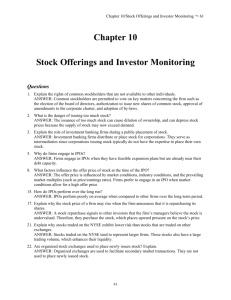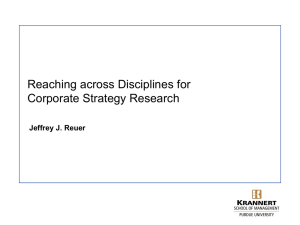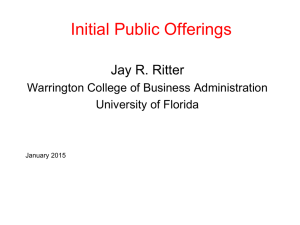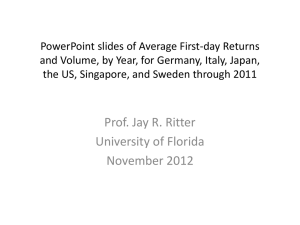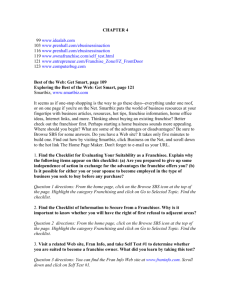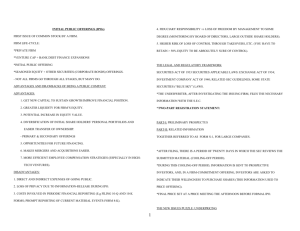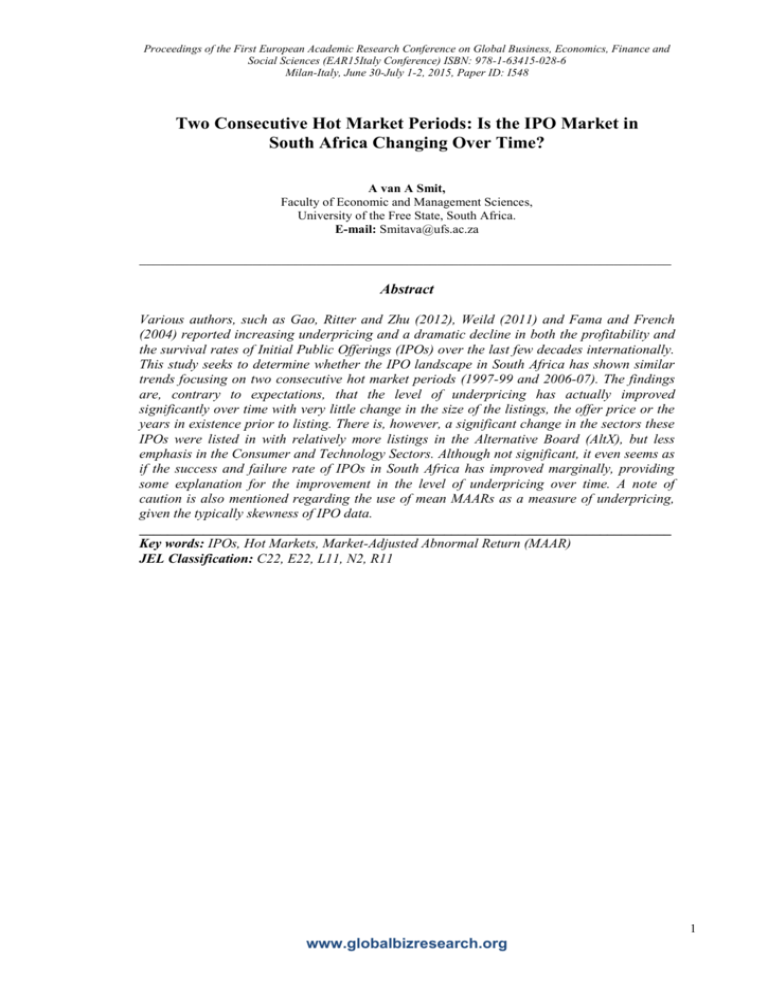
Proceedings of the First European Academic Research Conference on Global Business, Economics, Finance and
Social Sciences (EAR15Italy Conference) ISBN: 978-1-63415-028-6
Milan-Italy, June 30-July 1-2, 2015, Paper ID: I548
Two Consecutive Hot Market Periods: Is the IPO Market in
South Africa Changing Over Time?
A van A Smit,
Faculty of Economic and Management Sciences,
University of the Free State, South Africa.
E-mail: Smitava@ufs.ac.za
___________________________________________________________________________
Abstract
Various authors, such as Gao, Ritter and Zhu (2012), Weild (2011) and Fama and French
(2004) reported increasing underpricing and a dramatic decline in both the profitability and
the survival rates of Initial Public Offerings (IPOs) over the last few decades internationally.
This study seeks to determine whether the IPO landscape in South Africa has shown similar
trends focusing on two consecutive hot market periods (1997-99 and 2006-07). The findings
are, contrary to expectations, that the level of underpricing has actually improved
significantly over time with very little change in the size of the listings, the offer price or the
years in existence prior to listing. There is, however, a significant change in the sectors these
IPOs were listed in with relatively more listings in the Alternative Board (AltX), but less
emphasis in the Consumer and Technology Sectors. Although not significant, it even seems as
if the success and failure rate of IPOs in South Africa has improved marginally, providing
some explanation for the improvement in the level of underpricing over time. A note of
caution is also mentioned regarding the use of mean MAARs as a measure of underpricing,
given the typically skewness of IPO data.
___________________________________________________________________________
Key words: IPOs, Hot Markets, Market-Adjusted Abnormal Return (MAAR)
JEL Classification: C22, E22, L11, N2, R11
1
www.globalbizresearch.org
Proceedings of the First European Academic Research Conference on Global Business, Economics, Finance and
Social Sciences (EAR15Italy Conference) ISBN: 978-1-63415-028-6
Milan-Italy, June 30-July 1-2, 2015, Paper ID: I548
1. Introduction
An Initial Public Offering (IPO) is the preferred transition or exit strategy for high growth
private companies to become a publicly-traded company (Draho, 2004:1). Ravasi and
Marchisio (2012:18) identified ‘to finance and growth and development’, ‘to facilitate
external growth’, ‘to improve the company’s image / status’ and ‘to increase visibility’ as the
most important reasons for going public. The ability to raise additional capital in the primary
market is thus a very lucrative opportunity not only for high growth companies, but also as a
means of harvesting for existing shareholders (Firer, Ross, Westerfield and Jordan,
2012:466). But, one of the downsides of going public is that the owners of the relatively
unknown private company have to make it attractive to investors to buy the shares; an issue
called underpricing.
In almost all stock markets around the world IPOs are characterized by initial
underpricing and long-term underperformance. Underprising refers to the difference between
the initial price the IPO company offers its shares to the public and the closing price in the
market after the first day of trading (Heeley, Matusik and Neelam, 2006:2), indicating a loss
to existing shareholders for ‘leaving money on the table’. The levels of underpricing in
different markets and different time periods vary significantly. Chen, Firth and Jeong-Bon
(2004) reported underpricing of 145% in China, Boulton, Smart and Zutter (2007)
demonstrated evidence of underpricing for Indonesia (41%), Malaysia (41%), South Korea
(44%), Taiwan (13%), and Thailand (26%) while Loughran, Ritter and Rydqvist, (2010:1-2)
reported positive average first day returns from 47 countries around the world. The average
initial returns (underpricing) varied from as low as 4.2% in Russia to as high as 164.5% in
China.
However, the timing of all these listings, such as in hot or cold market periods, could
influence the level of underpricing significantly. A hot market issue is defined by periods of
rising initial returns and increasing numbers of IPOs (Doeswij, Hemmes and Venekamp,
2006). Hot markets are also characterized by a window of opportunity where IPOs are highly
valued and companies take advantage of a buoyant market (Jaskiewicz, Gonzalez, Menendez
and Schiereck, 2005). Prior research ( Almisher, Buell and Kish, 2002; Alti, 2005) have
shown that IPOs in hot markets are severally underpriced with extraordinarily high variability
of initial returns. Agarwal (2006) affirms that hot IPO markets are characterized by an
unusually high volume of offerings, severe underpricing, frequent oversubscription of
offerings, prevalence of smaller issues, and, to a certain extent, by concentrations in particular
industries or sectors. Neneh and Smit (2013:899) confirmed significant underpricing of 95.7%
of IPOs in hot market periods in South Africa as opposed to only 4.9% in cold market periods
with similar results found by Van Heerden and Alagidede (2012:130). Although this paper
2
www.globalbizresearch.org
Proceedings of the First European Academic Research Conference on Global Business, Economics, Finance and
Social Sciences (EAR15Italy Conference) ISBN: 978-1-63415-028-6
Milan-Italy, June 30-July 1-2, 2015, Paper ID: I548
focuses on the level of IPO underpricing in hot market periods in South Africa, the main
purpose is to determine whether there are significant changes in the IPO market over time.
The trend observed and documented across different stock markets has been that the long
term success rate of IPOs is decreasing (Gao, Ritter & Zhu, 2012 and Fischer & Pollock
2004). Other studies also indicate a steady increase in IPO failure over the last twenty years
despite the fact that the average company displays promising fundamentals in terms of market
capitalization and age (Weild, 2011; Demers & Joos, 2006). Loughran and Ritter (2004:41)
found that the level of initial under-pricing in the US market increased substantially (from
7.4% in 1980-89, 14.8% in 1990-98 to 65.0% in 1999-2000).
Fama and French (2004) also reported a dramatic decline in the survival rates of IPOs
over the last few decades. Loughram and Ritter (2004:5) confirm that the level of
underpricing increased since the 1980s due to, amongst other reasons, more risky and younger
IPOs being listed. Weild (2011) and Fisher and Pollock (2004) confirmed that the success rate
of IPOs over the last few decades has declined, regardless of the increase in the size and
maturity of IPO deals. The higher failure rates of IPOs over time provide a possible
explanation for the higher levels of underpricing. Neneh and Smit (2013:900) established that
the market-adjusted abnormal return (MAAR) did increase in two consecutive hot market
periods from 87.4% in 1997 to 1999 to 113.7% in 2006 to 2007 in South Africa. The main
purpose of this study is to compare two consecutive hot periods (1997 to 1999 and 2006 to
2007) on the JSE in South Africa to determine whether the IPO market in South Africa has
changed significantly over time. Three significant adjustments were however made regarding
the initial research by Neneh, Negek and myself (Smit), namely the sample size have been
increased, more sources were consulted to verify abnormal returns as well as significant
outliers were excluded from the sample to get a true reflection of the IPO changes over time.
2. Literature Review
The JSE was established in November 8, 1887 as a stock exchange in South Africa and it
is now one of the top twenty security exchanges in the world in terms of market capitalisation
(Alli, Subrahmanyam and Gleason, 2010:4). The JSE has two boards namely the JSE Main
Board and the JSE Alternative (AltX) board. AltX is the alternative exchange launched in
2003 as a nursery for the JSE main board, which aimed at replacing the unsuccessful venture
capital and development capital boards established as sub divisions of the main board in the
1980s. AltX was created to provide small to medium sized enterprises (SMEs) who had
smaller income/profits and had not been in existence for a long time, with a public listing
option, and conditions that were not as strict as the ones for the JSE Main Board (Manikai,
2011:8). The AltX caters for a segment of the market which would have found it difficult to
3
www.globalbizresearch.org
Proceedings of the First European Academic Research Conference on Global Business, Economics, Finance and
Social Sciences (EAR15Italy Conference) ISBN: 978-1-63415-028-6
Milan-Italy, June 30-July 1-2, 2015, Paper ID: I548
be listed on the JSE Main Board due to its inability to meet with the listing requirements and
its perceived riskiness.
The first issue to be addressed is whether the level of underpricing between the two
consecutive hot market periods has increased. The high levels of underpricing are often
associated with issues such as information asymmetry, the winner’s curse theory and the
signaling hypothesis (Neneh, 2013:56-59). Underpricing arises because both the investors and
the public have little or no information regarding the company going public and thus have to
rely on the information disclosed by the business. One solution companies follow to reduce
the information asymmetry between informed and uninformed investors and to compensate
for this issue companies is to deliberately under-price their IPO’s (Firer et al., 2012:472). The
goal of this strategy by companies is to increase the level of trading of their own shares and to
increase the profit potential for the average investor. Brau & Facett (2006:414) added that
underpricing can be seen as a marketing scheme to attract potential investors, increasing their
market range. According to Álvarez and González (2005:35) the hype created by an IPO may
cause an overreaction by the market, which can lead to a speculative decision by an investor
to invest a substantial amount in an IPO without sufficient information and thus not getting a
return on his or her investment. Underpricing could therefore be associated with long-term
underperformance of IPOs. Thus, because of the worldwide phenomenon of poor long term
performance of IPOs, companies deliberately under-price their shares to compensate for the
poor, long term performance (Firer et al., 2012:472). If the level of underpricing therefore
increased over time, it would be reasonable to assume that more information asymmetry is
expected, thus explaining higher expected failure rates amongst IPOs in the second hot
market period.
Several studies (M’kombe and Ward, 2002:10; Hughes and Lee, 2006:5, Sohail and
Raheman, 2009:63; Sahoo and Rajib, 2010:27; Durukan, 2002; Demers and Joos, 2005:17;
Carpentier and Suret, 2011) have identified characteristics of IPO companies such as the
company’s age, timing of issue (hot and cold market periods), issue size, profitability, market
capitalisation, offer size, gross proceeds, leverage, price to book value (P/B), market to book
value (M/B), financial ratios, pre-IPO performance, and technical riskiness (measured by
sector and R&D intensity) to be significant determinants of IPO initial and long-term returns
as well as the success and failure of IPOs. In this study, IPO characteristics are classified into
offer price, market capitalization, company’s age, sector classification and success versus
failure.
Deb and Vijaya (2010) reported that the issue size had a negative impact on the level of
underpricing; suggesting that a large issue size increases the supply of IPO shares, and thus
results to lesser underpricing. These findings indicate that the smaller the size of the issue, the
4
www.globalbizresearch.org
Proceedings of the First European Academic Research Conference on Global Business, Economics, Finance and
Social Sciences (EAR15Italy Conference) ISBN: 978-1-63415-028-6
Milan-Italy, June 30-July 1-2, 2015, Paper ID: I548
higher the level of underpricing. Furthermore researchers (Carpentier and Suret 2011; Demers
and Joos 2007; and Hensler, Rutherford and Springer, 1997) established that younger
companies experience a higher post issue failure rate and thus suggesting a negative
relationship between company’s age at IPO and the level of underpricing. Issues such as
information asymmetry, moral hazard and adverse selection are likely to arise in contractual
arrangements between issuing company and external providers of finance (investors). These
problems may well be more severe obstacles to the listing of young and smaller companies,
and the associated costs much higher for young and smaller companies that have a low
visibility and little proven track records.
Moreover, Finkle and Lamb (2002) compared the long run aftermarket performance of
IPOs in emerging industries (biotechnology, semiconductor and internet IPOs) to those in
non-emerging industries during the period between 1993 and 1996. This study found that the
returns from emerging industry after a year were worse than those of non-emerging industry,
but nevertheless, the performance for both industries were negative.
IPO failure is often defined as the delisting of a company from the primary exchange on
which it traded with a delisting code between 500 and 585 (Foster-Johnson, Lewis and
Steward, 2001). The delisting codes are codes that indicate the reason a company is delisted
from the stock exchange. IPO failure is defined by Fischer and Pollock (2004) as the delisting
of a company from the primary exchange either because of bankruptcy or inability of a
company to maintain minimum requirements. Wruck (1990) defines failure by financial
criteria as the lack of sufficient cash flows to satisfy current obligations. Altman and Hotckiss
(2005) stress that failure by economic criteria means that “the realized rate of return on
invested capital, with allowances for risk consideration, is significantly and continually lower
than prevailing rates on similar investments”. IPO failure is also viewed as the poor returns
earned relative to the risk of undertaking the investment (Raputsoane, 2009:1). Various
studies proposed competing theories and concepts on IPO failure and its measurement criteria
(Chava and Jarrow, 2004; Campbell, Hilscher, and Szilagyi, 2008; Beaver, McNichols, and
Rhie, 2005).
In summary, prior research internationally indicates an increase in IPO failure with more,
a decrease in the number of IPOs listed with higher levels of underpricing and changing
characteristics of the typical IPO listed and the research question addressed in this paper is
whether this is also applicable to the South African stock market.
3. Methodology
3.1 Research Questions
The fundamental research question addressed in this paper is whether the South African
IPO landscape in two consecutive hot market periods (1997 to 1999 versus 2006 to 2007)
5
www.globalbizresearch.org
Proceedings of the First European Academic Research Conference on Global Business, Economics, Finance and
Social Sciences (EAR15Italy Conference) ISBN: 978-1-63415-028-6
Milan-Italy, June 30-July 1-2, 2015, Paper ID: I548
have changed significantly. To answer the primary research question, the following secondary
research questions have been formulated regarding the two consecutive hot market periods:
Did the level of underpricing using the market-adjusted abnormal return (MAAR)
increase significantly over time?
Did the inflation adjusted offer price change significantly over time?
Did the average size (market capitalization), adjusted for inflation, of the IPOs change
significantly over time?
Were more mature IPOs listed over time?
Did the IPO market in terms of different sectors change significantly over time?
Did the success rate of the IPOs deteriorate significantly over time?
3.2 Statistical Analyses
In this paper, the statistical analyses, such as cross tabulation, chi-square, one-way
analysis of variance (ANOVA), T-test, regression analysis, and Pearson correlation
coefficient were done using excel and the Statistical Package of Sciences (SPSS) statistical
software.
The market-adjusted abnormal return (MAAR) has been the most widely used method in
calculating underpricing (Van Heerden and Alagidede, 2012:132). The market-adjusted
abnormal return (
) for stock ‘x’ after ith, trading period is calculated as follows:
The market-adjusted model measures the initial returns (offer price versus closing price
after first day of trading) in excess of the market return. The JSE All Share Index (ALSI) was
used to calculate the market return.
The average market-adjusted abnormal return for the ith trading period is.
Where
= the sum of the market adjusted abnormal return of the sample IPOs
divided by the number of sample IPOs.
To test the significance of
, the following t-statistic is calculated:
Where‘s’ is the standard deviation of MAAR x, i for a ‘n’ number of companies.
For comparative purposes, this study will adopt the mean market-adjusted abnormal return
(
), which is the standard method for calculating underpricing of new issues and t-
6
www.globalbizresearch.org
Proceedings of the First European Academic Research Conference on Global Business, Economics, Finance and
Social Sciences (EAR15Italy Conference) ISBN: 978-1-63415-028-6
Milan-Italy, June 30-July 1-2, 2015, Paper ID: I548
stats to measure the significance of the level of underpricing. Testing for the symmetry of the
standard deviation (normal distribution), the following measure of Skewness (Hair, Black,
Baben, Anderson and Tatham, 2006:80-81) was used (Z value exceeding ±2.58 indicates nonnormal distribution at a significance level of 0.01):
Where n is the number of IPOs in the sample.
3.3 Data
The sample for the study comprised of 390 IPOs that were listed on the Johannesburg
Securities Exchange (JSE) from 1996 to 2011 as was available in the McGregor-BFA
database, the Stock Exchange Handbook, the companies’ initial prospectus, as well as data
provided by the JSE. According to the JSE database, 482 IPOs were listed over the 16 year
period, indicating a sample size in this study of 80.9%. The reasons for excluding some of the
IPOs are a) detailed data (such as offer prices and number of shares issued) for some of the
IPOs were not available on the McGregor-BFA database, b) inconsistency in the specific IPO
data amongst the various sources, and c) unexplainable outliers that jeopardized the reliability
of the data. It was crucial to exclude an IPO if discrepancies in the various data sources could
not be resolved. Previous studies by Neneh, Ngek and myself relied exclusively on the
McGregor-BFA database (Neneh & Smit, 2013; Smit and Ngek, 2014). Verifying the
individual IPO data using four sources led to adding many more IPOs to the sample, but more
importantly, it also created the opportunity to exclude any inconsistent data and unexplained
outliers, thus increasing the reliability of the data. The substantially bigger sample size,
combined with the exclusion of certain IPOs from the study, have influenced the empirical
results from previous papers and articles, specifically regarding MAAR and the factors
impacting both initial underpricing and long-term success.
The JSE All Share Index (ALSI) was used to calculate market return and the CPI
(Consumer Price Index) was used to adjust the offer price and issue size (market
capitalization) for inflation. The IPOs were also classified into six sectors, namely Basic
Materials (Mining/Minerals), Consumer Goods and Services, Industrial, Financial,
Technology and Venture Capital (AltX). The Alternative Exchange (AltX) creates a unique
opportunity for companies to list if they do not comply with the requirements of the Main
Board (such as profit history, size of the listing, subscribed capital, etc.).
Failure was defined as all IPOs delisted from the JSE with reasons such as ‘failure’, ‘no
longer quality for listing’, ‘failure to comply with JSE requirements’ and ‘Section 17 of the
Stock Exchanges Control Act 1985’. If there was an increase in the share price in absolute
terms from the original offer price over a seven year period, the IPO was regarded as
7
www.globalbizresearch.org
Proceedings of the First European Academic Research Conference on Global Business, Economics, Finance and
Social Sciences (EAR15Italy Conference) ISBN: 978-1-63415-028-6
Milan-Italy, June 30-July 1-2, 2015, Paper ID: I548
successful, at least in absolute terms. The IPOs who were delisted for other reasons or had a
market price less than the original offer price over a period of seven years were classified as
“Other”.
4. Results and Discussion
From a sample of 390 IPOs Table 1 clearly indicates two hot market periods since 1996
to 2011 in the South African stock market with 67.2% of all the listings in five of the 16 years
investigated. The initial returns (MAAR) on the first day of trading also confirm underpricing
of 38.19% with significant differences in MAAR in the different years. These results differ
slightly from previous studies (Neneh and Smit, 2013; Smit and Ngek, 2014) because of the
increase in the sample size as well as the elimination of unexplainable outliers. The
underpricing was also significantly higher in the hot market periods (53.3%) compared to the
cold market periods (7.3%), but the main focus of the paper is comparing the two consecutive
hot market periods with each other.
Table 1: Annual Market-Adjusted Abnormal Returns of IPOs on the JSE
Year
No. Of IPOs
% of IPOs
MAAR D1
Cold Market
1996
21
5.4%
12.01%
Hot Market 1
3
168
43.1%
70.32%
1997
46
11.8%
62.75%
1998
72
18.5%
99.24%
1999
50
12.8%
35.64%
6
64
16.4%
8.62%
2000
10
2.6%
12.36%
2001
8
2.1%
-6.54%
2002
9
2.3%
7.35%
2003
6
1.5%
-2.09%
2004
13
3.3%
17.80%
2005
18
4.6%
10.84%
2
94
24.1%
22.80%
1997-98
Cold Market
2000-05
Hot Market 2
2006
35
9.0%
27.43%
2006-07
2007
59
15.1%
20.09%
Cold Market
4
43
11.0%
3.10%
2008
16
4.1%
2.32%
2009
10
2.6%
1.89%
2010
6
1.5%
5.10%
2011
11
2.8%
4.24%
16
390
100.0%
38.19%
2008-11
Total
Significance
.007***
***Significant at 1%; **Significant at 5%; *Significant at 10%
In Table 2 the results are summarized confirming that the level of underpricing in both
hot and cold markets is significant using T-Stats. It also indicates that the level of
8
www.globalbizresearch.org
Proceedings of the First European Academic Research Conference on Global Business, Economics, Finance and
Social Sciences (EAR15Italy Conference) ISBN: 978-1-63415-028-6
Milan-Italy, June 30-July 1-2, 2015, Paper ID: I548
underpricing of IPOs is significantly higher in hot markets than in cold markets confirming
results from previous studies. Contradictory to expectations, in the second part of Table 2 it
was established that the first day MAAR was significantly lower for the second hot market
period than the first hot period with substantially fewer IPOs listed in the second hot market
period. Another observation was the size of the standard deviations for MAAR in both hot
periods, which justified further investigation.
Table 2: Market adjusted abnormal return (MAAR) for the period 1996-2007
No. of IPOs
MAAR Day 1
Std. Dev.
T Stats
1996-2011
390
38.2%
96.8%
7.7936***
Cold Markets
128
7.3%
21.3%
3.8872***
Hot Markets
262
53.3%
114.2%
7.5509***
Hot Market 1
168
70.3%
137.5%
6.6265***
Hot Market 2
94
22.8%
34.3%
6.4589***
Significance
0.000***
Significance
***Significant at 1%
0.001***
If we assume a MAAR of between 0.0% and 19.9% as reasonably normal, negative first
day returns and MAARs exceeding 20.0% are regarded as abnormal, with MAARs exceeding
100.0% as extremely abnormal. In Table 3 IPOs were classified according to the size of
MAAR for the two hot market periods. The results were fairly similar for IPOs with MAARs
of less than 100.0%, but the first hot market period had significantly more IPOs with a
MAAR exceeding 100.0% (20.8% with an average MAAR of 276.0%) than the second hot
market period (only 3.2% of IPOs with an average MAAR of 137.3%). It seems therefore that
the main reason for the difference in underpricing between Hot Market Period 1 and 2 is the
skewness of the data, thus the number of IPOs with a MAAR exceeding 100.0% (see Table
4).
Table 3: Number of IPOs with abnormal MAARs
Hot 1: 1997 - 1999
% of IPO's
No. Of IPOs
Hot 2: 2006 - 2007
MAAR
Day 1
MAAR
Day 1
% of IPO's
168
94
MAAR Cat.
< 0.0%
17.9%
-17.8%
23.4%
-6.3%
0.0 to 19.9%
31.5%
9.0%
38.3%
7.7%
20.0 - 100.0%
29.8%
44.2%
35.1%
48.4%
> 100.0% **
20.8%
276.0%
3.2%
137.3%
Avg. MAAR
70.3%
Avg. MAAR**
79.2%
16.2%
96.8%
** MAAR of IPOs excluding those with MAARs exceeding 100%
22.8%
19.1%
9
www.globalbizresearch.org
Proceedings of the First European Academic Research Conference on Global Business, Economics, Finance and
Social Sciences (EAR15Italy Conference) ISBN: 978-1-63415-028-6
Milan-Italy, June 30-July 1-2, 2015, Paper ID: I548
When comparing the means, Table 4 confirms that the hot market period in 1997 to 1999
had significantly higher underpricing than the second hot market period in 2006 to 2007.
However, if we compare the Z score for Skewness, the MAARs for both hot periods deviated
significantly from normal, indicating that the mean MAAR is not a true reflection of the level
of underpricing, but is significantly influenced by the number of IPOs with a MAAR
exceeding 100.0%. If these outliers are excluded from the results, the adjusted mean MAARs
for hot period 1 is 16.2% and 19.1% for hot period 2. Even the median MAAR becomes a
better indicator for the level of underpricing if the significance of the Skewness is taken into
account.
Table 4: Skewness of MAAR between Hot Market 1 and 2
Hot 1
70.32%
168
Hot 2
22.82%
94
Sig.
Mean (MAAR)
No. Of IPOs
Std. Deviation
137.54%
34.26%
0.001
Median (MAAR)
Skewness
20.16%
3.14
10.60%
1.73
Z (Skewness)
6.79***
2.80***
Adj. MAAR**
16.20%
19.05%
*** Significant at 1%
In the next few tables other indicators, such as the offer price, market capitalization (size),
years of existence before listing, sectors and success versus failure are assessed to verify
whether the IPOs in two consecutive hot periods on the JSE differ significantly. It is
important to note that given the relative high levels of inflation, combine with the fact that
these IPOs were listed over a period of 16 years, it was essential to adjust both the offer price
and the market capitalization (size) for inflation.
Table 5: Offer Price, Size and Maturity of IPOS in two Hot Markets
Inflation Adjusted
HOT MARKET 1 VS 2:
Mean
Hot Market
1997-99
1:
Offer Price
1 098
No. Of IPOs
168
Std. Deviation
6 492
Median
Skewness
Z (Skewness)
168
9 278
155
206
289
3
12.32
6.11
12.66
13.20***
27.35***
2 142
14
94
94
94
2 336
6 140
21
Median
257
482
7
Skewness
4.27
6.09
6.90***
9.84***
Std. Deviation
Z (Skewness)
Significance
before Listing
22
168
1 085
No. Of IPOs
2:
Market Cap.
2 521
26.62***
Mean
Hot Market
2006-07
Years Exist
0.985
0.635
2.73
4.42***
0.723
10
www.globalbizresearch.org
Proceedings of the First European Academic Research Conference on Global Business, Economics, Finance and
Social Sciences (EAR15Italy Conference) ISBN: 978-1-63415-028-6
Milan-Italy, June 30-July 1-2, 2015, Paper ID: I548
Table 5 clearly indicates that the inflation adjusted offer price (R1 098 in hot period 1 to
R1 085 in hot period 2) were very similar. Regarding both the size (market capitalization) and
maturity (years of existence before listing), there are no significant differences between the
two consecutive hot periods. Again the level of Skewness for all three indicators are
significant, indicating that we cannot assume a normal distribution. The median values could
therefore be a more true reflection of the differences between the two hot periods.
Table 6: IPOs listed in different Sectors comparing the two hot periods
Percentage IPOs Listed
Sector
Hot Mark. 1
Hot Mark. 2
No. Of IPOs
168
94
Basic Materials
4.2%
Consumer
Industrial
19.6%
7.7%
18.1%
4.3%
Financial
16.7%
4.3%
Technology
3.2%
Venture/AltX
17.3%
34.5%
Significance
0.000***
14.9%
55.3%
The results in Table 6 clearly indicate that there was a shift in sectors regarding the listing
of IPOs in the two consecutive hot periods. As was expected there were substantially more
technology stocks listed in the period 1997 to 1999, as well as IPOs in the consumer and
financial sectors, while the period 2006 to 2007 saw a major increase in basic materials
(resources) to capitalize on the higher mineral prices that were typical of that period. What is
also interesting to observe is the significant increase in IPOs getting listed on the alternative
board (AltX) from hot market 1 to hot market 2. A possible explanation for this phenomenon
could be that many companies find it difficult to comply with the main board requirements.
Lastly the IPOs were classified as successful or failed over a period of seven years, with the
“Other” category as all those IPOs who either delisted or merged or a with share price of less
its original offer price.
Table 7: Failed versus Successful IPOs
Percentage IPOs Listed
Sector
Hot Mark. 1
Hot Mark. 2
No. Of IPOs
168
94
Success
17.9%
21.3%
Failed
32.7%
27.7%
Other*
49.4%
51.1%
Significance
0.302
From Table 7 it can be observed that there is no significant change regarding the failure
or success of IPOs on the JSE in the two consecutive hot market periods. Although not
significant, it appears that the IPOs performed marginally better in the last hot market period.
11
www.globalbizresearch.org
Proceedings of the First European Academic Research Conference on Global Business, Economics, Finance and
Social Sciences (EAR15Italy Conference) ISBN: 978-1-63415-028-6
Milan-Italy, June 30-July 1-2, 2015, Paper ID: I548
Over the period 1996 to 2011 two distinct hot market periods can be observed (1997 to
1999 and 2006 to 2007) with, as expected, significantly higher levels of underpricing in the
hot markets (53.3%) than in the colds markets (7.3%). However, the main focus of this
research was to establish to what extent the characteristics of the two consecutive hot market
periods have changed and the results were in many cases quite contradictory to popular belief.
As was expected, the number of IPOs listed in the second hot market period (94) was
substantially less than in the first hot market period (168). What was, however, surprising was
that the level of underpricing (MAAR) decreased from 70.3% for the first hot period to only
22.8% for the second hot market period
Closer examination revealed significant Skewness of the MAARs in the two hot periods,
indicating that the mean MAAR is not a true reflection of the level of underpricing. If the
outliers with MAAR in excess of 100% were excluded from the sample, the two hot periods
had very similar levels of underpricing (16.2% in 1997-99 compared to 19.01% in 2006-07).
Hot market period 1 had just more outliers (20.8%) than hot market period 2 (3.2%).
Focusing on the characteristics, the offer price, the market capitalization (size) and the
maturity (years in existence before listing) of the IPOs indicate no significant differences
between the two consecutive hot periods. Using the sectors in which the sampled IPOs were
listed, there was a significant change with fewer IPOs in the last hot market period listed in
the Technology, Consumer and Financial Sectors, but an increase of IPOs in the Basic
Materials and AltX Sectors. Although there was no significant difference regarding the
survival rate of the sampled IPOs between the two hot market periods, it seems as if the IPOs
in the last hot market period did marginally better in terms of both success and failure, which
could explain the lower levels of underpricing of IPOs in 2006-07 as compared to 1997-99.
5. Conclusions and Recommendations
The main goal of this research paper was to verify whether the IPO landscape in South
Africa, focusing on two consecutive hot market periods (1997-99 and 2006-07), show similar
trends of declining numbers of newly listed companies, increasing failure rates and thus
higher levels of underpricing over time. Gao, Ritter and Zhu (2012:1), reporting a major
decline in the number of IPOs listed in the USA, ask the question “where have all the IPOs
gone?” They came to the conclusion that small company IPOs have had declining
profitability, consistently lower returns for investors and an increasing likelihood of being
involved in acquisitions.
The results of this study highlights, in many cases, remarkably different results for the
South African IPO market over time. With the focus on two consecutive hot period markets,
the results indicated that the number of IPOs listed did decline substantially, but that the level
of underpricing, against all expectations, decreased significantly from 70.3% for 1997-99 to
12
www.globalbizresearch.org
Proceedings of the First European Academic Research Conference on Global Business, Economics, Finance and
Social Sciences (EAR15Italy Conference) ISBN: 978-1-63415-028-6
Milan-Italy, June 30-July 1-2, 2015, Paper ID: I548
22.8% for 2006-07. However, closer examination of the level of underpricing indicated that
huge difference in the level of underpricing between the two hot markets was primarily
caused the skewness of the data, thus the number of IPOs with a MAAR exceeding 100% was
much higher in the first hot market period. If these few outliers with excessive underpricing
were excluded from the sample, there was little change in the level of underpricing over time.
In contrast to previous studies (Weild, 2011; Demers and Joos, 2005), other surprising
findings were that the characteristics of the IPOs listed in two consecutive hot markets, such
as the inflation adjusted offer price and market capitalization (size) did not change
significantly, nor did the age of the companies prior to listing decreased. Regardless of a shift
in the number of IPOs listed in the AltX Sector, there was also no significant change in IPO
failure rates over time, which most probably explains the improvement in the level of
underpricing in the South African stock market.
It could therefore be concluded that all indications are that the IPO market in South
Africa has stabilized after the huge IPO bubble in the late 1990s. Some of the most important
recommendations emanating from this research are a) compare similar periods with each
other, such as two consecutive hot markets, before coming to any conclusions regarding
changing IPO characteristics, levels of underpricing or IPO failure, and b) given the typical
skewness of IPO data, specifically in hot periods, isolate outliers or even use the median to
report on changing levels of underpricing. All indications are that the IPO market in South
Africa is alive and well and showing marginal improvements regarding underpricing and
failure since 1996. Further research could be conducted on the long-term performance of the
IPOs over time to find potential explanations for the improvement in the levels of
underpricing.
References
Agarwal, S., 2006, The New Issue Puzzle: IPO Pricing in the Hot and Cold Markets in India.
This dissertation is submitted as a part of the requirements for the award of the MA Finance
and Investment.
Alli K.L., V. Subrahmanyam and K.C. Gleason, 2010, Short and long-run performance of
IPOs in post-apartheid South Africa. Working paper. Mercer University, Atlanta.
Alti, A., 2005, IPO Market Timing. Review of Financial Studies 61, 1681-1709.
Almisher, A.M., G.S. Buell and J.R. Kish, 2002, The relationship between systematic risk and
underpricing of the IPO market. Research in Finance 19, 87 – 107.
Altman, E.I. and E. Hotchkiss, 2005, Corporate Financial Distress and Bankruptcy: Predict
and Avoid Bankruptcy, Analyze and Invest in Distressed Debt. 3rd Edition, John Wiley &
Sons, New Jersey.
13
www.globalbizresearch.org
Proceedings of the First European Academic Research Conference on Global Business, Economics, Finance and
Social Sciences (EAR15Italy Conference) ISBN: 978-1-63415-028-6
Milan-Italy, June 30-July 1-2, 2015, Paper ID: I548
Álvarez, S. and V.M. González, 2005, Signaling and the long-run performance of Spanish
initial public offerings (IPOs). Journal of Business Finance & Accounting 32 (1), 325-350.
Beaver, W. H., F.M. McNichols and J. Rhie, 2005. Have Financial Statements Become Less
Informative? Evidence from the Ability of Financial Ratios to Predict Bankruptcy. Review of
Accounting Studies 10 (1), 93-122.
Boulton, J.T., B.S. Smart and J.C. Zutter, 2007, IPO underpricing and international corporate
governance. Journal of International Business Studies 41, 206–222.
Brau, J. and S. Fawcett, 2006, Initial public offerings: an analysis of theory and practice. The
Journal of Finance 90 (1), 399-436.
Campbell, J., J. Hilscher, and J. Szilagyi, 2008, In search of distress risk. Journal of Finance
63, 2899–2939.
Carpentier, C. and J.M. Suret, 2011, The survival and success of Canadian penny stock IPOs.
Small Business Economics 36, 101-121.
Chava, S. and R. Jarrow, 2004, Bankruptcy Predictor with Industry Effects. Review of
Finance 8, 537-569.
Chen G., M. Firth and K. Jeong-Bon, 2004, IPO underpricing in China’s new stock markets.
Journal of Multinational Financial Management 14, 283-302.
Draho, J., 2004, The IPO Decision: Why and how companies go public. North Hampton
Massachusetts UK. Edward Elgar Publishing Limited.
Deb S.S. and M.B. Vijaya, 2010, Information content of IPO grading. Journal of Banking and
Finance 34, 2294-2305.
Demers, E and P. Joos, 2005, IPO Failure Risk: Determinants and Pricing Consequences. An
International Meeting of the American Accounting Association. August 7–10, San Francisco,
California.
Demers, E. and P. Joos, 2007, IPO Failure Risk. Journal of Accounting Research 45 (2), 333371.
Doeswij, R.Q., H.S.K. Hemmes and R.H. Venekamp, 2006, 25 years of Dutch IPOs: an
examination of frequently cited IPO anomalies within the main sectors and during hot and
cold issue periods. De Economist 154, 154-405.
Durukan, M.B., 2002, The relationship between IPO returns and factors influencing IPO
performance: case of Istanbul Stock Exchange. Managerial Finance 28 (2), 18-38.
Fama E. and K. French, 2004, New Lists: Fundamentals and Survival Rates. Journal of
Financial Economics 73 (2), 229-269.
Finkle, T.A. and R.P. Lamb, 2002, A comparative analysis of the performance of emerging v.
non-emerging industry initial offerings. Journal of New England Journal of Entrepreneurship
5 (1).
14
www.globalbizresearch.org
Proceedings of the First European Academic Research Conference on Global Business, Economics, Finance and
Social Sciences (EAR15Italy Conference) ISBN: 978-1-63415-028-6
Milan-Italy, June 30-July 1-2, 2015, Paper ID: I548
Firer, C., S. Ross, R. Westerfield and B. Jordan, 2008, Fundamentals of Corporate Finance.
4th Edition. Berkshire: McGraw-Hill.
Fischer, H.M. and T.G. Pollock, 2004, Effects of social capital and power on surviving
transformational change: The case of initial public offerings. Academy of Management
Journal 47, 463-481.
Foster-Johnson, L., C.M. Lewis and J.K. Steward, 2001, Busted IPOs and windows of Misopportunity. Working paper, Dartmouth College. Hanover, NH.
Gao, X., J.R. Ritter and Z. Zhu, 2012, Where have All the IPOs gone? Online, retrieved from:
http://fisher.osu.edu/supplements/10/12092/Where%20Have_April_3_2012.pdf. Accessed 31
March 2015.
Hair, J.F., W.C. Black, B.J. Babin, R.E. Anderson and R.N. Tatham, 2006, Multivariate Data
Analysis. Pearson Prentice Hall, New Jersey, Sixth Edition.
Heeley, M.B., F.S. Matusik and J Neelam, 2006, Innovation, appropriability and the
underpricing of initial public offering. Online, retrieved from: http://www.aom.pace.edu/amj/
unassigned/heeley.pdf. Accessed 25 August 2014.
Helwege, J. and N. Liang, 2004, Initial Public offerings in Hot and Cold Markets. Journal of
Finance and Quantitative Analysis 39 (3), 541-569.
Hensler, D. A., R.C. Rutherford and T.M. Springer, 1997, The survival of initial public
offerings in the aftermarket. Journal of Financial Research 20, 93-105.
Hughes, A. and J. Lee, 2006, what’s in a name and when does it matter? The hot and cold
market impacts on underpricing of certification, reputation and conflicts of interest in venture
capital backed Korean IPOs. CBR Working Paper Series WP336, Centre for Business
Research, University of Cambridge, Cambridge, December.
Jaskiewicz, P., M.V. Gonzalez, S. Menendez and D. Schiereck, 2005, Long-Run IPO
Performance Analysis of German and Spanish Family-Owned Businesses. Family Business
Review 18 (3), 179-202.
Loughram T. and J. Ritter, 2004, Why has IPO Underpricing changed over time. Financial
Management Autumn, 5-37.
Loughram T., J.R. Ritter and K. Rydqvist, 2010, Initial Public Offerings: International
Insights Pasific-Basin Finance Journal 2, 165-199.
Manikai, B., 2011, Short, Medium & Long-Term IPO Performance in South Africa: JSE AltX versus JSE Main Board – The Post JSE Alt-X Evidence (2004-2007).Thesis submitted in
fulfilment of the requirements for the degree of Master of Management in Finance &
Investment in the Faculty of Commerce, Law and Management Wits business school at the
University of the Witwatersrand, Johannesburg.
15
www.globalbizresearch.org
Proceedings of the First European Academic Research Conference on Global Business, Economics, Finance and
Social Sciences (EAR15Italy Conference) ISBN: 978-1-63415-028-6
Milan-Italy, June 30-July 1-2, 2015, Paper ID: I548
M’kombe, M. and M. Ward, 2002, Aftermarket Price Performance of Initial Public Offerings
on the JSE. Investment Analyst Journal 55, 7-20.
Neneh. B.N. and A.v.A. Smit, 2014, Underpricing of IPOs during hot and cold market periods
on the South African Stock Exchange (JSE). International Scholarly and Scientific Research
and Innovation 7 (7), 896-903.
Neneh, B.N., 2013, Returns on initial public offerings (IPOs) on the Johannesburg Securities
Exchange (JSE): Success and failure patterns. Doctoral Thesis, University of the Free State,
Bloemfontein, South Africa.
Padachi, K., M.S. Narasimhan, R. Durbarry and C. Howorth, 2008, An analysis of working
capital structure and finance patterns. Journal of Applied Finance 14(7), 41-62.
Raputsoane, L., 2009, The risk-return relationship in the South Africa stock market. Paper
presented at the 4th Annual Conference on Econometric modelling for Africa, Centre for
Econometrics and Allied Research (CEAR), University of Ibadan, Nigeria.
Ravasi D. and G. Marchisio, 2012, Family Firms and the Decision to go Public: A Study of
Italian IPOs. Working Paper No. 01-45. SDA Bocconi University, Research Division.
Sahoo, S. and P. Rajib, 2010, After Market Pricing Performance of Initial Public Offerings
(IPOs): Indian IPO Market 2002-2006. Vikalpa 35 (4), 27-43.
Smit, A.v.A. and N.B. Ngek, 2014, Initial Public Offerings (IPOs) on South African
Securities Exchange (JSE): Can Underpricing assists Investors in their Decision Making
Process? 8th International Business Conference. Swakopmund, Namibia. 19-21 August 2014,
58-70.
Sohail, M. K. and A. Raheman, 2009, Determinants of Under-Pricing of IPOs Regarding
Financial & Non-Financial Firms in Pakistan. European Journal of Economics, Finance and
Administrative Sciences 15, 63-73.
Van Heerden, G and P. Alagidede, 2012, Short run underpricing of initial public offerings
(IPOs) in the Johannesburg Stock Exchange (JSE). Review of Development Finance 2 (3-4),
130-138.
Weild, D., 2011, Markets burning: the Loss of the Revenue Model Needed to Support Stocks
is Destroying Capital Formation IPO Market Structural and Regulatory Issues GovernmentBusiness Forum on Small Business Capital Formation. Washington, DC November 17, 2011.
Online,
retrieved
from:
http://www.sec.gov/info/smallbus/sbforum111711-materials-
weild.pdf. Accessed 26 February 2015.
Wruck, K. H., 1990, Financial Distress, Reorganization and Organizational Efficiency.
Journal of Financial Economics 27, 419-444.
16
www.globalbizresearch.org


